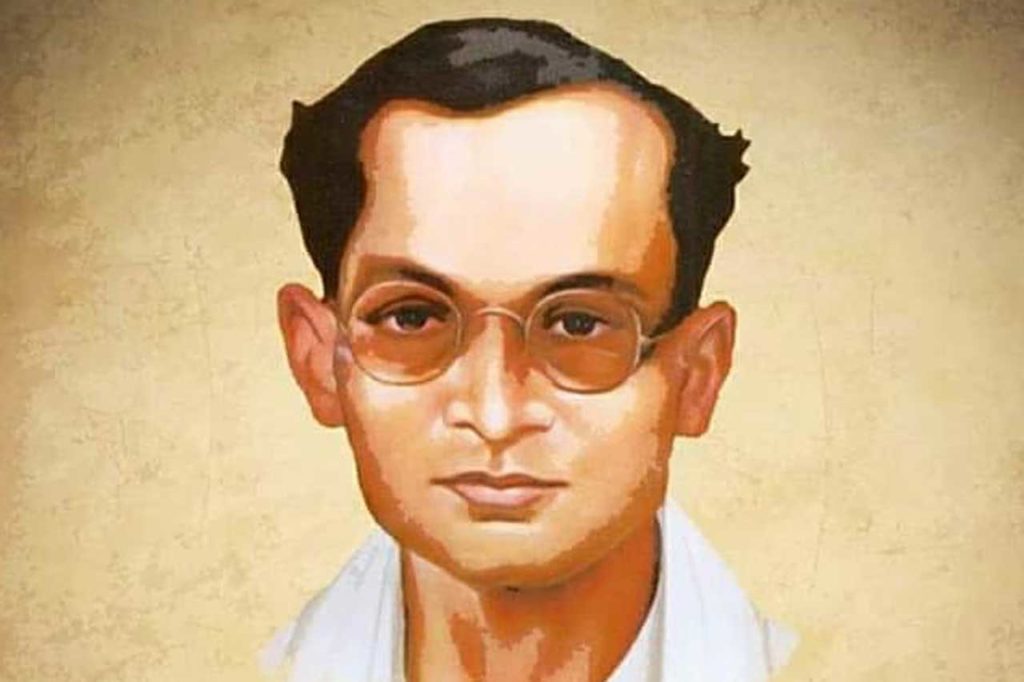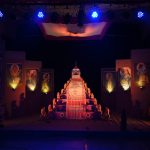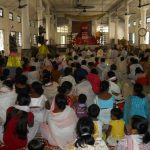Jyotiprasad Agarwala, the doyen of Assamese culture was conferred the popular title Rupkonwar (Prince of beauty) by poet Anandachandra Barua in 1938. It was a befitting title for an artist who had so much of aesthetic sense that people found the word ‘beauty’ synonymous with him. He had a normal feature, a lean and thin man with high cheek bones. He was not even an actor or regular singer, who made people crazy. But the verse or plays coming out from his restless pen aroused such urge for pure platonic love and internal beauty in people’s psyche that he became the symbol of beauty. He dreamt that there would be reign of Gandhism all over the world. He hoped that humanity would worship truth and beauty. It was a dream and continues to be a dream; but such dreams keep humanity going.
There was a smooth mixture of revolution and art in Jyotiprasad. He was nearer to Najrul Isalm than Subhash Chandra Bose in this respect. Jyotiprasad was an artist revolutionary. Of course at the same time he was also a revolutionary artist. We will come to that later. But we do not find in Jyotiprasad the type of confrontationist nationalism as Subhash Chandra preached, in spite of the fact that Jyotiprasad was a direct student of Subhash Chandra in National College of Kolkata in 1922. He was pursuing intermediate studies there. Subhash Chandra was the Principal at that time. Surely and certainly Subhash Chandra influenced Jyotiprasad, but it was only as far as patriotism was concerned, not as far as strategy was concerned. Jyotiprasad was always original in his strategies.
Jyotiprasad was highly influenced by two stalwarts of India. They were Mahatma Gandhi and Sri Aurobindo. The religious approach to politics that these two giants followed attracted Jyotiprasad greatly. Mahatma Gandhi and Sri Aurobindo were true Indians in their approach to politics. They believed in the philosophy of Srimadbhagavadgeeta. Of course Sri Aurobindo was more philosophical as well as religious than Mahatma Gandhi. Sri Aurobindo believed in mental and intellectual works, while Mahatma Gandhi mixed the religious philosophy of Hinduism with the stark reality of Indian polity. From that point of view Jyotiprasad was nearer to Mahatma Gandhi than Sri Aurobindo. But that was quite expected as he came into direct contact with Mahatma Gandhi, who happened to be guest in his home in Tezpur in 1929. Earlier in 1918 he had met Gandhiji for the first time when he went to the Congress session held in Ahmedabad alongwith his father. He was only fifteen at that time. Clearly he was influenced by Gandhiji during his formative years.
Obviously Jyotiprasad was a great patriot. He took active part in the Quit India movement of 1942. He was made the Chief Commandant of the All Assam Peace Force. He travelled throughout the state and mobilised people by singing his own patriotic songs. He was hiding in Kolkata for some time. Then he surrendered before police. He acted almost like Gandhiji in many matters. He was so respectful of Gandhiji that in one of his compositions he even compared Gandhiji with lord Krishna. Here he differed from Najrul Isalm, who used satirical words in the context of Gandhiji.
Though Jyotiprasad took active part in the freedom struggle, he was not a blind supporter of the Congress party just as Gandhiji himself was above the party. He disliked the trend of violence that crept into the Quit India movement in 1942. He did not accept Nehru as the real successor of Gandhiji. Even after the country gained independence, he was highly vocal against the policies of Congress party. This became fully evident in 1949 during the incident at Naliapul in Dibrugarh, where some people protesting against the government policy were brutally assaulted by the police leading to the death of five protesters. A police officer also was killed in this incident as there was violence from the protesters’ side also. Jyotiprasad was aghast at it. He condemened both sides for violence, with a bit more attack against the government. This incident as well his allegiance to the progressive forum Indian People’s Theatre Association brought out his socialist inclination clearly. But he never became a communist as sought to be made out by some communist writers. His ideology was that of a socialist democrat in the real sense of the term.
Now let us come to the point why we find Jyotiprasad as a revolutionary artist. He was a great admirer of Srimanta Sankaradeva and he practised the tunes created by the great cultural maestro and saint. The tunes of Bargeet created ripples in his heart. He played those tunes in his organ gifted to him by his father Paramananda Agarwala at a very tender age. But he did not play those tunes as they were. He created new tunes for his own modern song compositions using the tunes created by Srimanta Sankaradeva. In a way he was a remix artist and a pioneer in that expertise in entire India. His song Luitor parore ami deka lora ….. was based on the tune of the Bargeet Suno suno re sura bairee …… Most of his songs had folk base. He picked up melodies from even wedding songs. His famous song Gase gase pati dile phulore sorai ……. was based on Assamese wedding song tune and it created a new genre in Assamese music world. Then he presented the remixed melody in full orchestra, which was a novelty in those days. It was Jyotiprasad who introduced modern orchestra to the Assamese music world. Of course we find its predecessor in the devotional orchestra used by Srimanta Sankaradeva in his Nam-Kirtan, where cymbal, cattle drum, Khol, Negera etc were used so nicely. Jyotiprasad presented it in a modern form. But he did not use western instruments for that. His orchestra had all indegenous instruments of Assam only.
In fact Jyotiprasad was a great fusion artist. He made fusion of different types of music in his songs. He mixed Sankari music, Assamese folk music and Hindustani music. He blended them so nicely that a new homogenous composition resulted in the process. He took Bhupali, Durga and Bilawal Raga from Hindustani music. But no one could make out the original Raga on which he based the song as he blended that Raga with indegenous music in a fine manner. In all these Jyotiprasad was inspired by his own father Paramananda Agarwala, who was an expert musician excelling in playing the tunes of Srimanta Sankaradeva’s songs in organ. In fact the first and foremost influence in Jyotiprasad’s life was that of Paramananda as Paramananda’s rendering of Srimanta Sankaradeva’s compositions in organ fired the imagination of Jyotiprasad that modern music could be created with very much Assamese music, both classical and folk.
Jyotiprasad admired every thing that was created by Srimanta Sankaradeva. He termed the culture created by the saint as Krishna culture as the main theme of all compositions by the saint centred around devotion to Krishna. It was an apt name. Moreover this name linked Srimanta Sankaradeva with other Vaishnavite Gurus of India thematically. The stress on Krishna found is way to Jyotiprasad’s own compositions too as he followed Srimanta Sankaradeva avidly. He even termed Krishna as the friend and guide in his life in his song More jivanare sakha Krishna ……………… He said that Krishna stood for people’s power, which vanquished all evils in the society. Thus he took Krishna both as a spiritual entity and as a metaphor.
Jyotiprasad was a great feminist. He followed in the foot-steps of his role model Srimanta Sankaradeva, who had spoken of women’s rights way back in fifteenth-sixteenth century in compositions like Harishchandra Upakhyan and Uttarakanda Ramayana. Like any other Assamese litterateur-artist, Jyotiprasad also was influenced by the father of Assamese nation, Srimanta Sankaradeva. Jyotiprasad took up the cause of women in his stories and plays, which were almost always dominated by female characters. Even his film ‘Joymati’ was the saga of a great woman Joymati, whose sacrifice helped bring about a much needed political change during the Ahom reign. It is true, Jyotiprasad’s stories, plays and films had tragedy embedded in them. But he highlighted the aspirations and rights of women in his writings very forcefully. The tragedy added an extra dimension to that.
Jyotiprasad showed entrepreneurial spirit way back in early twentieth century, when there were very few entrepreneurs in the state. He was associated with tea industry as his family owned the famous Tamulbari Tea Estate. In fact he was born in that tea estate itself. Then he delved into the entertainment industry by making the first ever Assamese feature film Joymoti. Since there was no cinema hall to show films, he established the Jonaki cinema hall in Tezpur in 1937. Then he inspired his brother Tarun Kumar Agarwala to launch an Assamese daily Dainik Asomiya. But these entrepreneurship was not with the traditional profit motive of the capitalists. He believed in welfare economics. When he functioned as the resident director of the Tamulbari Tea Estate, he opened a school for the children of the labourers. Not only that, he sent his own children to study in that school. This was an unheard of thing. He clearly did not remain a capitalist any more. He was declassed. It was also pertinent that he liked children very much. That was why he wrote several stories for children. Of course that was quite expected from an artist with strong aesthatic and ethical sense.




